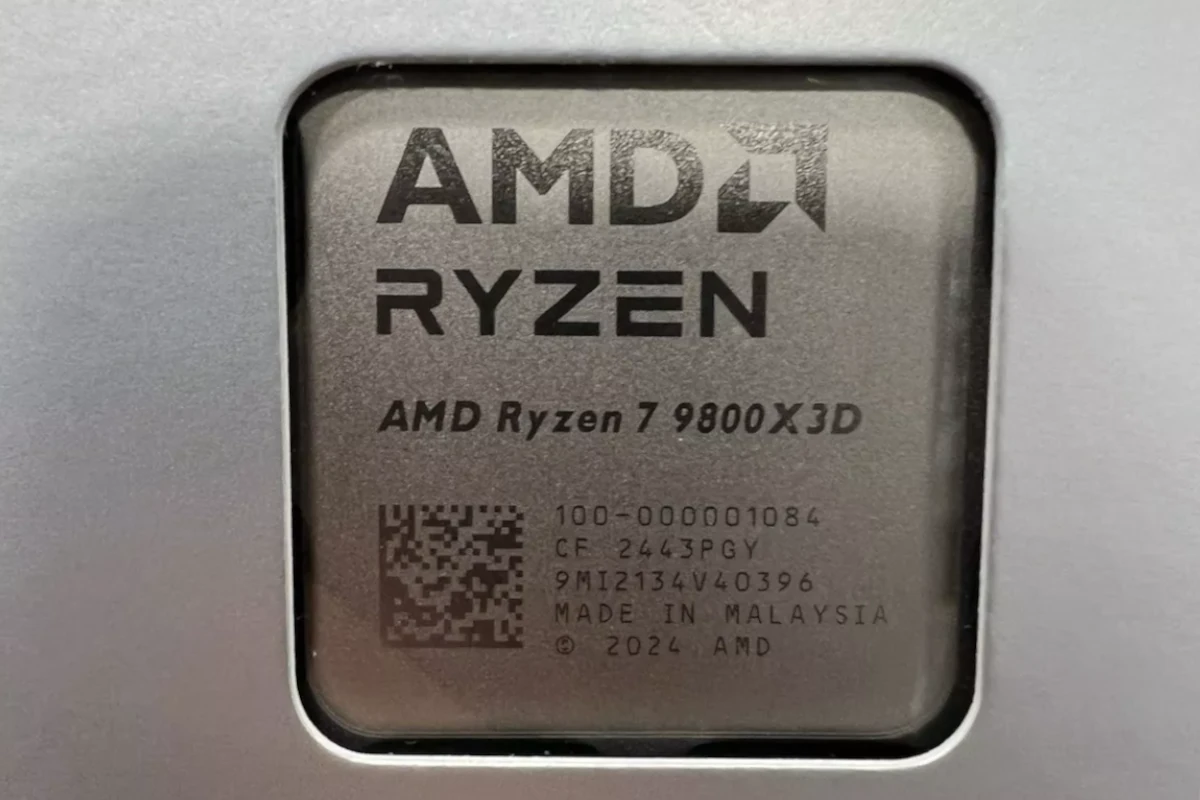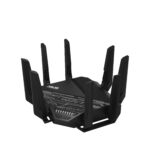AMD has released two powerful gaming processors: the Ryzen 7 9800X3D and the Ryzen 7 7800X3D. These CPUs feature AMD’s innovative 3D V-Cache technology, designed to boost gaming performance. The Ryzen 7 9800X3D outperforms its predecessor in gaming benchmarks, making it the fastest gaming CPU currently available.
The 9800X3D builds on the success of the 7800X3D, incorporating AMD’s latest Zen 5 architecture. This upgrade brings improvements in instructions per clock (IPC) and power efficiency. Gamers and enthusiasts seeking top-tier performance will find the 9800X3D particularly appealing.
Both processors offer 8 cores and 16 threads, but the 9800X3D boasts higher clock speeds. This advantage translates to better performance in CPU-intensive tasks and gaming scenarios. The 9800X3D also maintains similar power efficiency to its predecessor, despite the performance gains.
AMD Ryzen 9 9800X3D vs. Ryzen 7 7800X3D: Which Gaming CPU Reigns Supreme?

AMD’s X3D CPUs have made a name for themselves in the gaming world, offering impressive performance thanks to 3D V-Cache technology. But with the release of the Ryzen 9 9800X3D, gamers have a new option to consider. How does it stack up against the popular Ryzen 7 7800X3D? Let’s break down the key differences.
Specifications
| Feature | Ryzen 9 9800X3D | Ryzen 7 7800X3D |
|---|---|---|
| Cores/Threads | 8 cores / 16 threads | 8 cores / 16 threads |
| Base Clock | 3.4 GHz | 4.2 GHz |
| Boost Clock | Up to 4.5 GHz | Up to 5.0 GHz |
| L3 Cache | 96MB (3D V-Cache) | 96MB (3D V-Cache) |
| TDP | 120W | 105W |
| Socket | AM5 | AM5 |
| Price | ~$479 | ~$449 |
Gaming Performance
Both CPUs excel in gaming, thanks to their large L3 caches. The 7800X3D generally edges out the 9800X3D in gaming benchmarks, especially at 1080p resolution where CPU bottlenecks are more common. This is likely due to its higher clock speeds. However, the 9800X3D often delivers similar performance, and in some cases, even surpasses the 7800X3D at higher resolutions like 1440p and 4K.
Content Creation and Productivity
The 9800X3D pulls ahead in multi-threaded workloads like content creation and productivity tasks. Its higher core count allows it to handle these tasks more efficiently than the 7800X3D.
Power Consumption and Thermals
The 9800X3D has a slightly higher TDP (120W) compared to the 7800X3D (105W). However, in practice, the 7800X3D can sometimes run hotter due to the concentration of heat from the 3D V-Cache.

Price and Value
The 9800X3D is slightly more expensive than the 7800X3D. Whether the extra cost is justified depends on your needs. If gaming is your primary focus, the 7800X3D offers excellent value. But if you also need strong multi-core performance for other tasks, the 9800X3D is worth considering.
Which Should You Choose?
- Gamers: The 7800X3D is generally the better choice for pure gaming performance, especially at 1080p.
- Content Creators: The 9800X3D is the preferred option for tasks like video editing and 3D rendering.
- All-Around Users: If you need a CPU that can handle both gaming and productivity tasks, the 9800X3D offers a good balance.
Ultimately, the best choice depends on your individual needs and budget.
Understanding 3D V-Cache
AMD’s 3D V-Cache technology is a game-changer for CPU performance. It involves stacking extra L3 cache vertically on top of the CPU die. This dramatically increases the amount of cache available to the CPU, allowing it to access frequently used data much faster.
Benefits of 3D V-Cache
- Improved Gaming Performance: 3D V-Cache can significantly boost frame rates in games, especially at higher resolutions.
- Faster Application Loading: Applications and games load faster due to quicker access to data.
- Enhanced Multitasking: The increased cache helps with smoother multitasking and handling demanding workloads.
3D V-Cache is a key differentiator for AMD’s X3D CPUs, giving them an edge in gaming and other applications that benefit from large cache sizes.
Key Takeaways
- The Ryzen 7 9800X3D offers superior gaming performance over the 7800X3D
- AMD’s 3D V-Cache technology significantly enhances gaming capabilities in both processors
- The 9800X3D’s Zen 5 architecture provides improved efficiency and higher clock speeds
Processor Specifications and Architecture
The AMD Ryzen 7 9800X3D and 7800X3D processors offer significant advancements in core architecture, performance metrics, and cache hierarchy. These CPUs showcase the latest innovations in AMD’s processor technology.
Core Architecture and Technology
The AMD Ryzen 7 9800X3D features the new Zen 5 architecture, while the 7800X3D utilizes the Zen 4 architecture. Both processors boast 8 cores and 16 threads, providing robust multitasking capabilities.
The 9800X3D’s Zen 5 architecture brings improved Instructions Per Clock (IPC) and enhanced power efficiency. This newer design allows for better performance in various computing tasks.
Both CPUs incorporate AMD’s 3D V-Cache technology, which significantly increases the L3 cache size. This feature particularly benefits gaming performance by reducing memory latency.
Performance Metrics
The Ryzen 7 9800X3D outperforms its predecessor in several key areas:
- Base Clock Speed: 4.2 GHz
- Boost Clock Speed: Up to 5.25 GHz
- TDP: 120W
The 7800X3D, while slightly behind, still offers competitive performance:
- Base Clock Speed: 4.2 GHz
- Boost Clock Speed: Up to 5.0 GHz
- TDP: 120W
These specifications translate to improved frame rates in gaming and faster rendering times in content creation tasks. The 9800X3D shows particular strength in single-threaded performance due to its higher boost clock.
Cache and Memory Hierarchy
Both processors feature a sophisticated cache structure:
- L1 Cache: 512 KB (64 KB per core)
- L2 Cache: 8 MB (1 MB per core)
- L3 Cache: 96 MB (3D V-Cache)
The large 96 MB L3 cache, enabled by 3D V-Cache technology, significantly reduces memory latency. This feature is particularly beneficial for data-intensive applications and gaming.
Both CPUs support DDR5 memory, with the 9800X3D supporting up to 192 GB and the 7800X3D up to 128 GB. The newer 9800X3D may offer slightly improved memory controller efficiency due to its updated architecture.
Gaming Performance and Power Efficiency
The AMD Ryzen 7 9800X3D and 7800X3D processors offer impressive gaming capabilities with differing power consumption profiles. These CPUs cater to PC gamers seeking high-performance options for demanding titles.
Gaming Benchmarks
The Ryzen 7 9800X3D delivers devastating gaming performance, outpacing its predecessor in multiple titles. In Cyberpunk 2077, the 9800X3D shows significant frame rate improvements over the 7800X3D.
Hogwarts Legacy and A Plague Tale: Requiem also benefit from the enhanced architecture of the 9800X3D. Starfield, a game known for its CPU-intensive nature, runs smoother on the newer chip.
The 9800X3D consistently outperforms competitors like the Core i7-14700K and Core i9-14900K in gaming scenarios. This performance gap widens in CPU-bound situations, making it an attractive option for high-refresh-rate gaming.
Energy Consumption
Power consumption is a key differentiator between these processors. The 7800X3D, based on the Zen 4 architecture, demonstrates superior thermal efficiency.
The 9800X3D, while more powerful, draws more energy under load. This increased power draw can lead to higher temperatures, potentially causing thermal throttling in poorly cooled systems.
For users prioritizing energy efficiency, the 7800X3D offers a better balance of performance and power consumption. It maintains excellent gaming capabilities while keeping energy use in check.
Comparative Analysis
When comparing these CPUs, several factors come into play:
- Raw performance: 9800X3D leads
- Power efficiency: 7800X3D has an edge
- Thermal management: 7800X3D runs cooler
The 9800X3D shows a 30% gaming performance improvement over its predecessor in some scenarios. This leap makes it the top choice for users seeking maximum frame rates.
For budget-conscious gamers, the 7800X3D remains a strong contender. It offers excellent performance at a lower price point and with better power efficiency.
The integrated graphics capabilities of both CPUs are limited. For tasks requiring GPU acceleration, discrete graphics cards are recommended.







